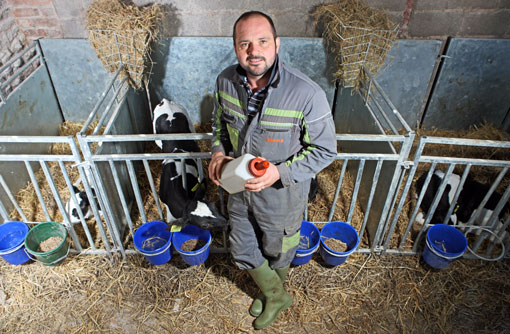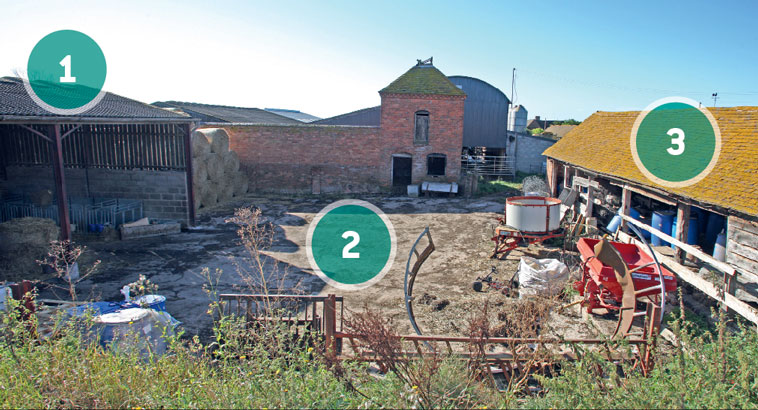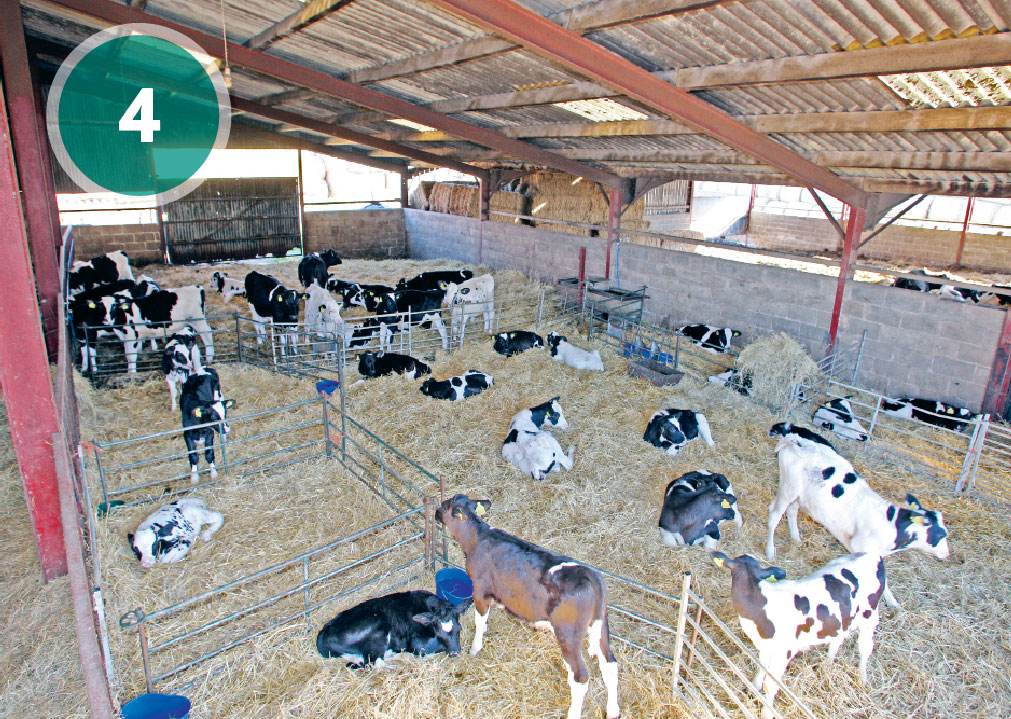Pneumonia Hit Squad: David Richards, Ridgend Farm, Worcestershire

As a follow-up from Farmers Weekly’s Youngstock: Stop the Loss campaign, a group of specialist advisors teamed up to form the Pneumonia Hit Squad and visited three producers to troubleshoot their calf-rearing systems.
The Hit Squad’s recommendations prove you don’t have to have a big, new set-up to get the best from your calves – it’s about making the most of the buildings you have. Aly Balsom reports from David Richards’ Ridgend Farm in Worcestershire.
How David Richards’ rearing system is set up
- 130 cows in milk, year-round calving
- 8,500-9,000 litres a cow a year
- Fresh cows hand-milked and calf bottled with 3 litres of colostrum as soon as possible after birth
- Calf taken off dam straight away
- Calves fed a total of 5-6 litres a day in two feeds
- Heifers receive milk powder, bulls fed waste milk
- 12-week weaning
- Various multipurpose buildings spread around farm and used for calves – from small tiled, brick sheds, to open-fronted, high-roofed buildings
- One open-fronted, high-roofed multipurpose shed has recently had six individual calf pens added at one end
- Main calf area currently in high roofed shed adjoining the parlour – calves housed here until four to five months old and then moved to separate farm
Issues identified by David Richards
- Using multipurpose buildings to house calves
- “Higgledy-piggledy” sheds spread around farm
- The flow of youngstock is the main challenge
- Losing 5% of calves to pneumonia, mostly around weaning
- “I’d like to be more regimented, but I don’t have the money for a new calf rearing unit,” said Mr Richards
Calf flow
To improve both calf and human flow through the system, the Hit Squad recommended setting up a specific, contained calf unit using existing buildings.
This would involve renovating a small, brick shed used for general storage, and putting older calves in a high-roofed shed opposite, which is currently earmarked for younger animals.
Commenting on this high-roofed, open-fronted barn containing six new pens for calves at one end, Mr Williams said: “Six pens of six baby calves will never drive ventilation in this shed. This shed is probably better for 20-30 calves of six to 10 weeks old.
“You would also need to open or raise the ridge or cut holes in the thermo-cement to provide an outlet.”
Mr Potter suggested using this shed for weaning. However, the slope on the floor would need changing so drainage was directed away from pens.
By modifying the small, brick shed opposite, the Hit Squad agreed that this would create an ideal, easily ventilated shed for smaller animals, because of the smaller internal air space and lower roof.
However, both air inlet and outlet would need to be addressed. The individual calf pens could then be moved into this building and loafing areas could be set up on the concrete between this shed and the new weaned shed opposite.
Currently, calves are housed in a high-roofed shed adjoining the parlour, which in itself creates issues, as small animals are again unable to ventilate such a large area. With stock remaining in this shed until about three to four months old, this also means mixed-age animals are sharing the same air space.
Mr Potter commented: “The main problem here is that the heat generated from the parlour and adult cows in the adjoining shed has nowhere to go, and condensation will fall on to the calf beds.” This could potentially create a disease challenge.
|
This area could be a dedicated youngstock unit. 1. Roof too high for baby calves to ventilate shed – use to wean into. 2. Set up central concrete space as loafing area. 3. Small, low roof makes this building ideal for baby calves. Would need renovating and inlet and outlet (open ridge) to drive ventilation. |
|---|
| 4. Space too large to ventilate for small calves. Mixed groups not ideal. Heat generated from parlour and neighbouring adults cows could negatively affect calf health as no escape outlet for it |
1. Think about the stocking rate of baby calves – don’t put up buildings that are too big and too high.
- There is the general belief that big, open spaces are good for ventilation, but you need enough animals to create heat to drive air flow, as well as adequate inlet and outlet.
- It’s worse to understock baby calves than to overstock, as they will be unable to drive ventilation.
- The problem with large, open buildings come on a still day.
- An adult dairy cow will generate 12 times as much energy as a calf.
2. Buildings need both an inlet and outlet
- Anything above the eaves is an outlet, anything below the eaves is an inlet.
- If you improve air inlet, you must also improve outlet at the same time.
- The greater the height between the ridge and the eaves, the less inlet and outlet you need.
- Have no more than an inch gap between space boards in sheds for baby calves.
- Mono-pitch buildings are less easily ventilated as stagnant air can gather at the back.
3. Assess colostrum quality and quantity early on
- If you don’t give calves a solid grounding in immunity you will hit problems later on. You could treat calves well from three weeks of age, but if you haven’t got it right from the beginning, you’re fighting a losing battle. Undertaking blood immunoglobulin testing at seven to 10 days old can give an idea of whether you’re giving enough good-quality colostrum and if you are giving it adequately.
4. Ideally buildings should be built for a specific purpose
- Before putting up a new shed, decide what it is going to be used for – is it a shed for calves on milk or weaned calves? This will change how you set up drainage and other facilities.
5. Roofing material will effect how a building is ventilated
- Tin roof temperature will vary considerably with ambient temperature – the effect can be like that of a boiling kettle on a mirror, with condensation gathering and potentially dripping on to the beds below. “Tiger stripes” on the roof can be an indication of this problem.
- Thermo-cement is a more stable roofing material than tin.
A building containing animals on a still day ventilates by a phenomenom known as the “stack effect”. The animals drive this with the heat they produce.
This hot air rises within the building and tries to escape through a high-level outlet. This creates a negative pressure within the building, sucking clean, dry, cooler air into the building through inlets. Outlets are above eaves height and inlets are below eaves height.
Think of the movement of air in a livestock building in a similar way to the movement of air/smoke in a fireplace. The animals have a similar role to that played by the fire – enough animals are needed to create enough heat to push air up and out of the building outlet (chimney).
Both inlets and outlets are needed to allow air to be pushed up and out of the building and new fresh air to be drawn in. It’s essential you have both. The most common finding in buildings is a lack of high-level outlet.
See the Hit Squad in action on farm in this video, and read about our other case studies at Boycott Farm in Yockleton, Shropshire, and Combe Farm in Castle Combe, Wiltshire.


